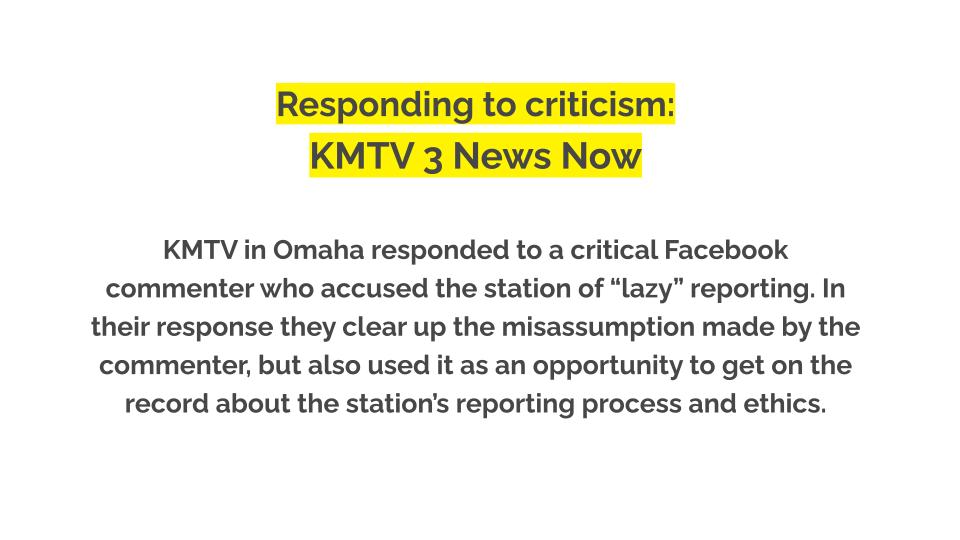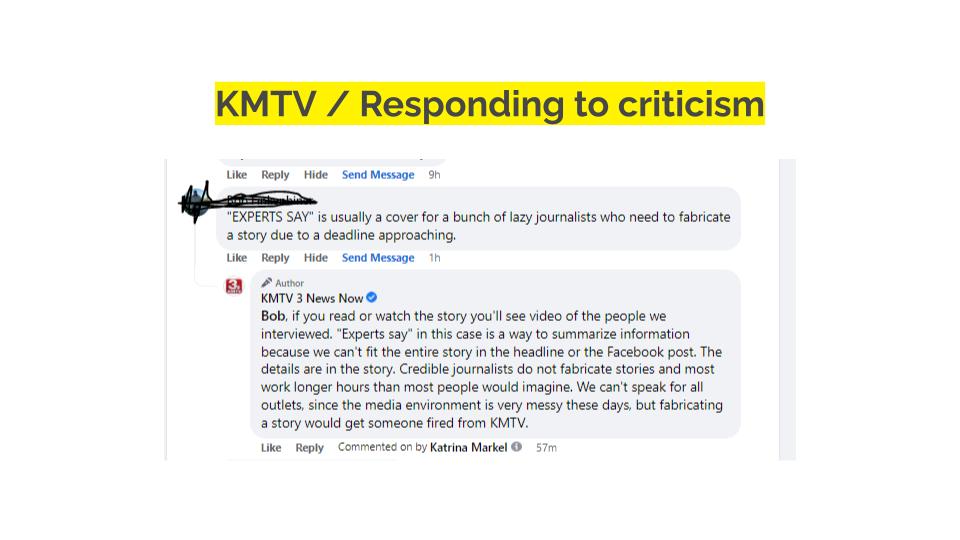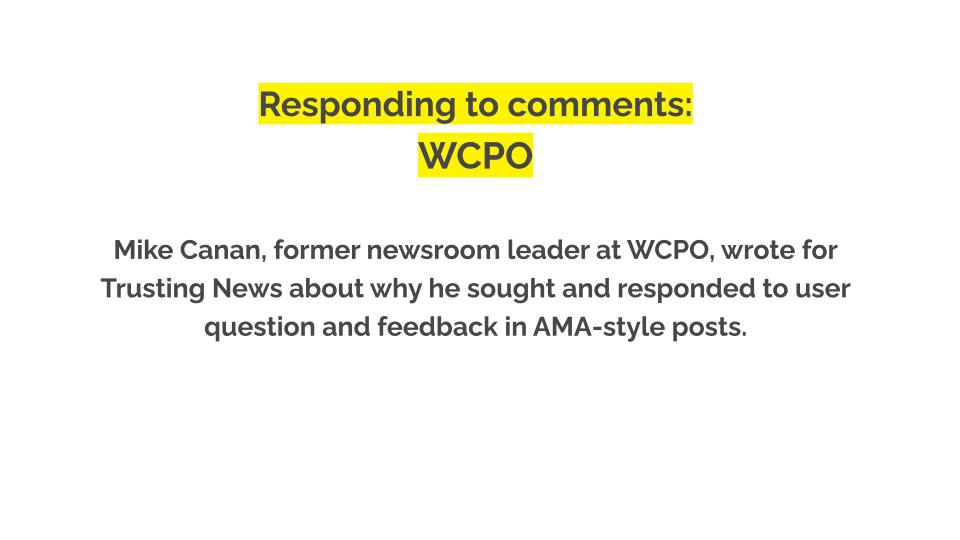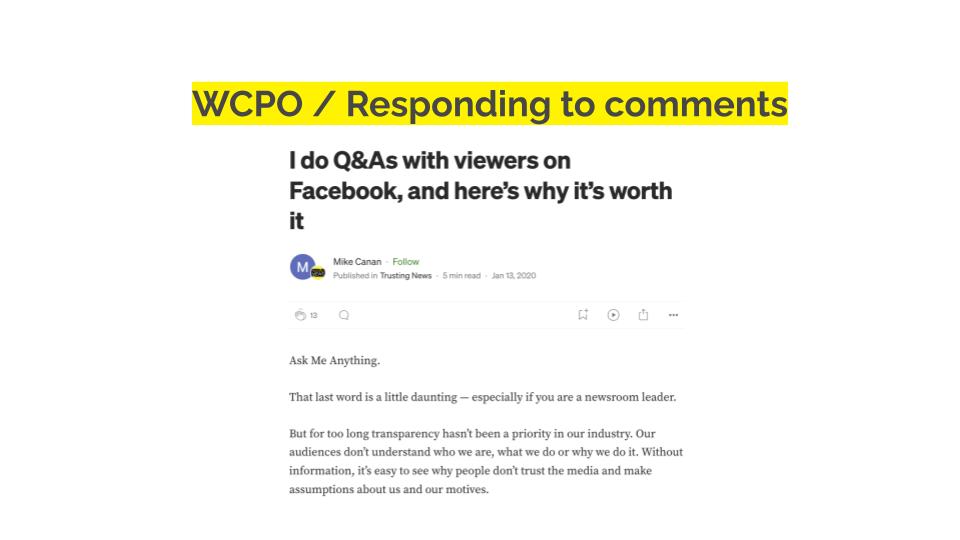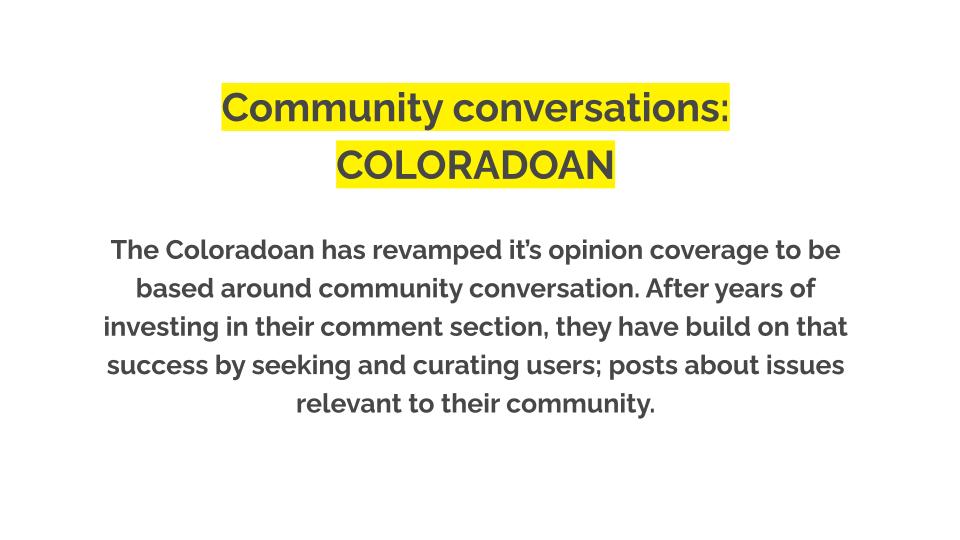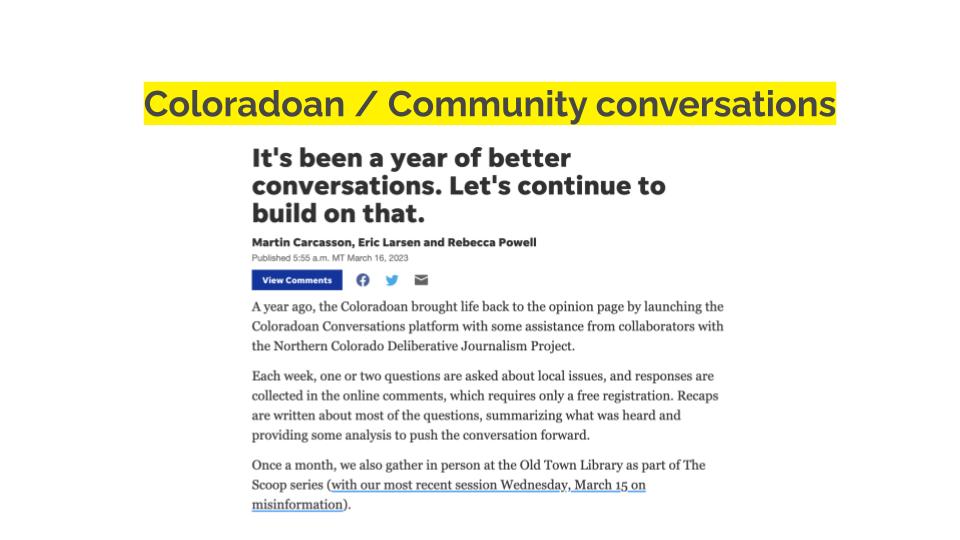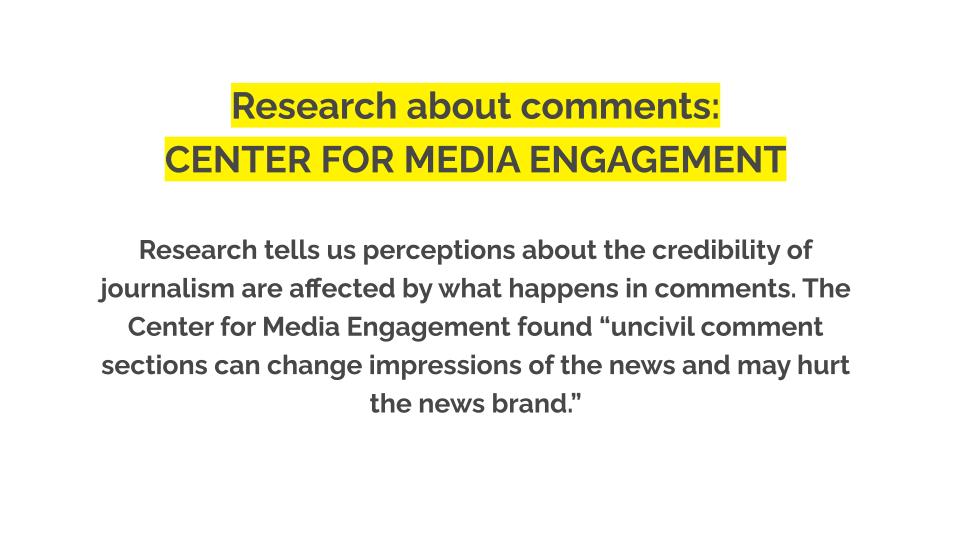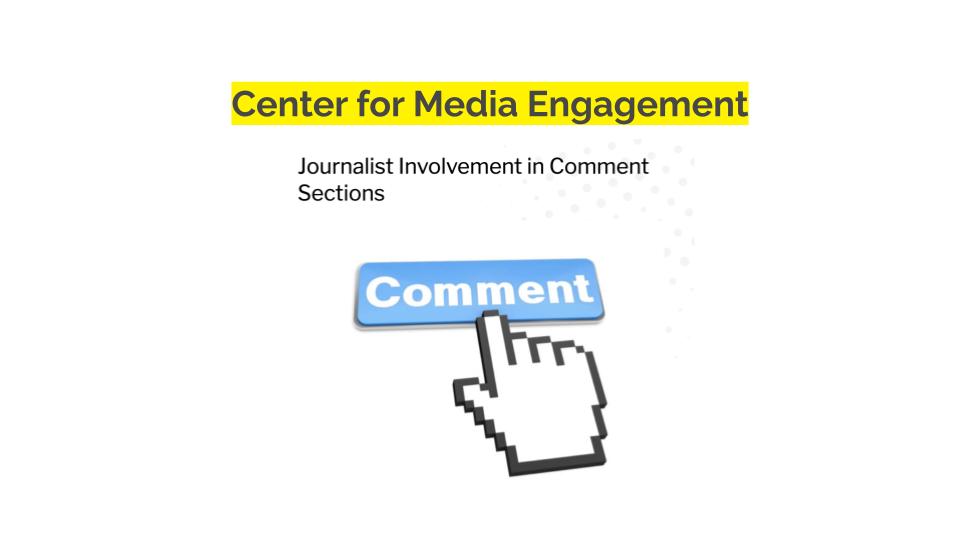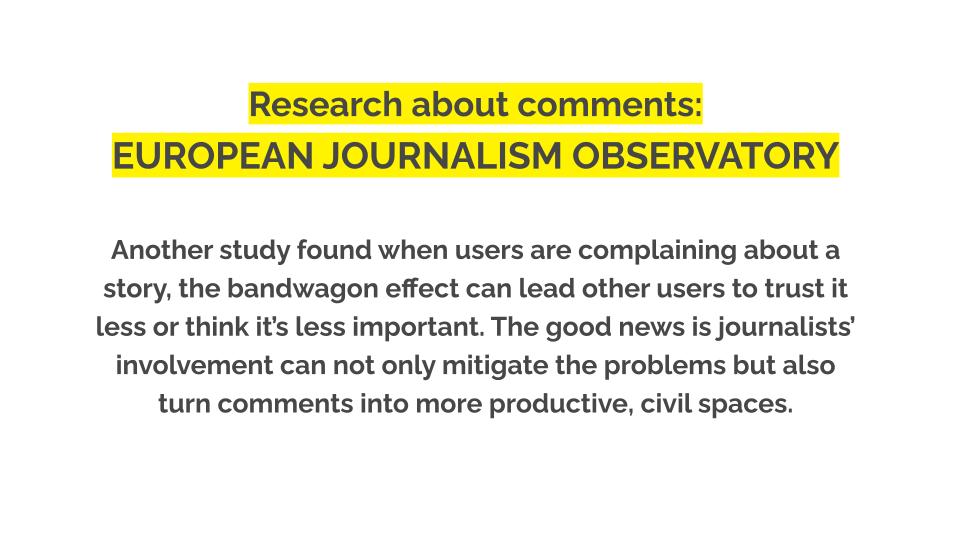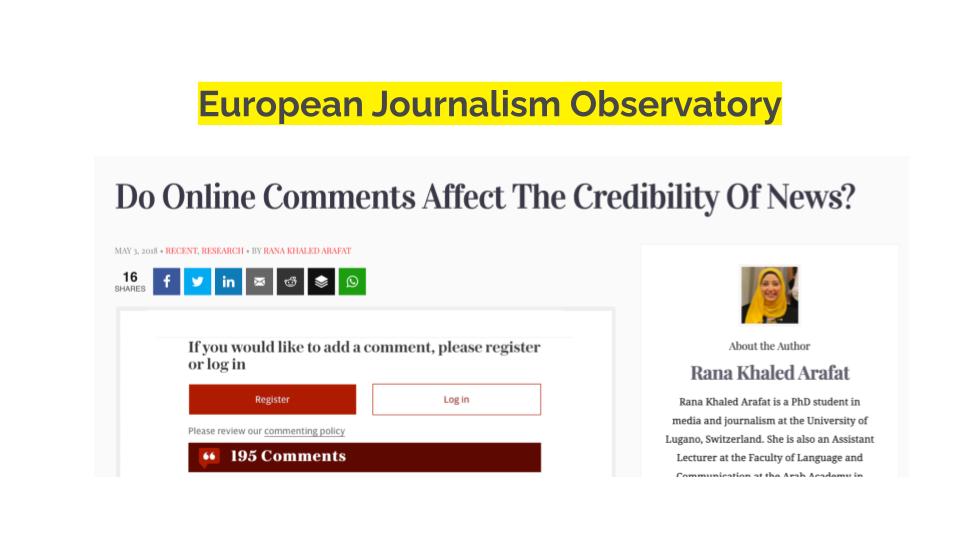ENGAGEMENT
Engaging through comments
The comment sections connected to news stories often resemble a poorly thrown party. Imagine you decide to have people over. You stock the bar, put on some music and throw open the door. And then you … leave. You hope (assume?) people will be on their best behavior, and you expect to come home to a house that’s still in order.
Ridiculous, right? We count on an event’s host to connect people, to gently redirect someone who gets a bit unruly and to call someone a cab and send them home if necessary. Everyone appreciates a host who values guest experiences. This is true in online comments as well. Journalists can and should play host — validating good behavior (hitting “like” on a user’s comment is so quick and simple), contributing to conversations, reprimanding people who are ruining the vibe and offering additional details about the topic being discussed.
Comments also represent a rich opportunity for journalists to tell the story of their work, get on the record about their integrity and answer questions about their ethics and process.
Comments are a rich opportunity for you to tell the story of your work, get on the record about your integrity and answer questions about your ethics and process.

Goals
This Trust Kit helps you:
- Understand how engaging with comments can build trust
- Craft language to use in responses to common concerns or complaints
- Make your comment engagement more efficient over time
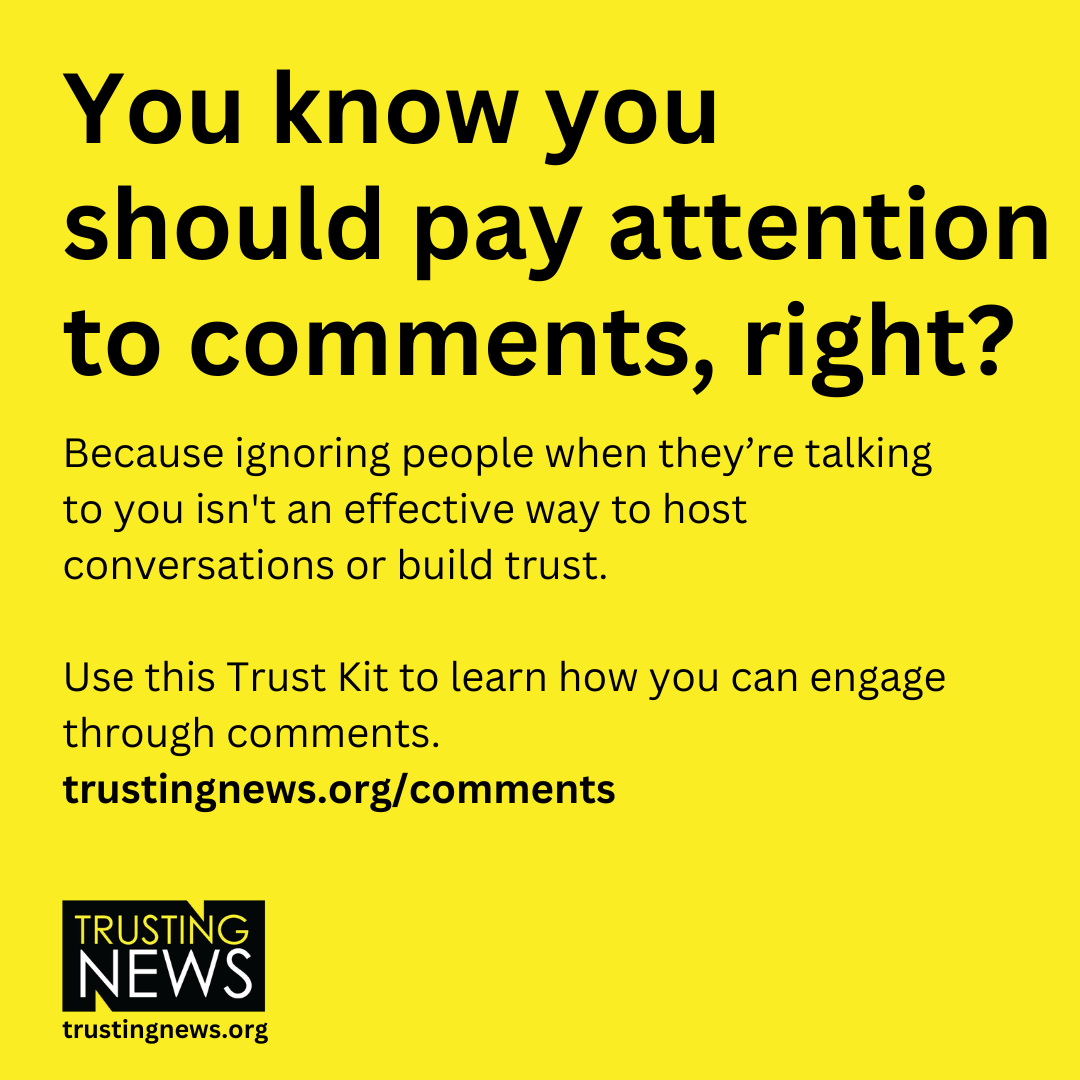

Strategies
Feeling overwhelmed by the idea of responding to comments? Use these strategies to help make moderating comments efficient and sustainable in your newsroom.
Click or tap the blue boxes to expand each section.
Plan your staff’s time and priorities to include comments
If people are talking to you, don’t ignore them — and don’t treat the task of interacting as something extra or optional. Comments serve as a powerful feedback loop for the newsrooms and can both contribute to editorial decision-making and play a customer service role. More: Check out our Trust Kit on how to gather audience input.
Try not to make moderating comments the job of one social producer. Share the duty — but keep in mind that not everyone may be prepared or ready to take it on. Don’t put the staffers who tend toward crankiness and defensiveness in charge of your brand’s response. You want people who actually like other people to moderate comments.
Chose high-profile opportunities
We know time is tight, so pick some high-profile stories to moderate comments on, where interest and attention will be above average.
Read comments, and show you're reading
Start by clicking “like” on productive comments and looking for chances to thank people for their feedback. That takes very little time.
Consider who’s reading (hint: it’s more than who’s writing)
Remember that when you post, you’re responding not just to the person who left a comment, question or complaint but to everyone else who is also reading the thread. If you decline to engage, you are ceding the conversation to the commenters. Do you want people to scroll past an accusation about your work and not find an accompanying rebuttal? Don’t let your detractors have open season on your credibility. And don’t let earnest, curious community members go unanswered when they inquire about your ethics and processes.
Have a comment policy
Write a policy that can apply anywhere you’re hosting a conversation. Be clear about what behavior you will allow and what you want to encourage. (If you need help writing one, the folks at Coral have a fantastic guide, with examples.)
Consider whether you can commit to deleting misinformation from comments, then let people know you’re doing it. Consider whether you want to allow commenters to speculate about the personal lives of people in stories, or air private grievances in your conversation space. If not, say so. But be sure to only promise moderation that you can follow through on. To set expectations, post your code of conduct or community guidelines on your website and pin the guidelines to social profiles and groups.
Invoke the comment policy when moderating, and explain yourself
Use that policy! Delete comments! Warn or ban people who blatantly break the rules! Doing so rewards people who follow the rules and is a sign of respect toward your commenting community.
When people break the rules, use the situation as an opportunity to remind people of your guidelines by reposting or linking to them. You could say something like:
“We know you value civility, and we do too. That’s why our comment policy sets some ground rules (include a link). We’ve banned a few commenters who were making personal attacks, and we’ll continue to keep an eye on things. Thanks to everyone who’s contributing to productive and respectful conversations.”
Look for chances to ask follow-up questions
Some commenters will be sharing their experiences or interests or curiosities. That’s a fantastic way that conversation can be an extension of the journalism. Things like “what else do you want to know about this” or “have you seen this in your neighborhood” can lead to story ideas and sources, and they can turn the comments into a productive form of journalism.
Educate people about your journalism
Because of their informal format, comments can be a great place to drop information and links about how you do your job. Look for chances to answer questions about the reporting and the coverage decisions. Remind people of your mission, your ethics, how you decide what to cover, who’s on your staff …. anything that feels relevant.
Defend your integrity, and reframe complaints as information gaps
If someone incorrectly accuses you of something or makes a misassumption about you, think of it as a sign that the person lacks important information. Reframe the complaint that way, then address it. Here’s an example.
- COMPLAINT: You’re only writing about this business because you’re out to get them!
- INFORMATION GAP: Why do journalists find it important to write stories that are critical of local businesses?
- RESPONSE: The health department has found repeated violations at this restaurant that are a matter of public safety. As journalists, one of our jobs is to alert the community to how their government is functioning and also to share information that helps keep people safe. We will be sure to also share when these violations are cleared up. Thanks for commenting.
Your goal isn’t necessarily to convince this specific commenter to find your coverage fair. It’s to set the record straight in a public conversation, to everyone who’s listening. Here’s another example:
- COMPLAINT: You do so many stories about this high school, and it’s because the sports editor went to school there. You’re so biased! Where’s the love for the other schools in town?
- INFORMATION GAP: How does the sports department decide what to cover?
- RESPONSE: Thanks for commenting. Our staff of three spreads out around the county and tries to get at least one game a season from each of the area teams. We do usually give more coverage to teams that are doing especially well, as this one has for the last couple of seasons. If you looked at our coverage five years ago, you’d see more stories about the cross-town rival.
Make engagement gradually more efficient
We know this work takes time. The good news is that there are ways to make it easier as you get more experience with it. Increase the efficiency of your responses — respond in public, and keep a copy
- Save your most frequent comment responses. If you have a nice paragraph written up about your paywall or your corrections policy, your commitment to fair coverage, save it! Consider a Google Doc, a Slack channel or any other shared space that’s easily searchable. Invite the newsroom to refer back to it. They’ll be much more likely to respond themselves — like to an angry reader in their inbox — if they don’t have to start from scratch. Your time crafting answers becomes much more valuable when you put a process in place to extend the utility of the responses and save your staff time.
- Look for chances to share more broadly what you’ve already shared in a comment. If a journalist has already written a paragraph explaining how they fact-checked a story or how advertising dollars don’t influence news coverage, repurpose that explanation. Turn it into a Facebook post or an Instagram story. Put it in a newsletter. Put it in a box alongside a related story. Use it responding to emails. The language can be simple: “We know readers are curious about xxx. Here’s how that works.” Or, if you have permission: “Reader Ben Jones gave us permission to share this question he asked us, along with our answer to his email. Submit your question at xxx.”
- Turn off the comments if needed. If the party you host is going to be unruly, disrespectful or out of control, it’s better not to throw it in the first place. Consider your options (on your website and on Facebook specifically) for turning off comments entirely or for allowing them only in specific instances.

General conversation tips
Be mindful of your tone. It can take a deft touch to respond to a cranky and/or uninformed commenter. Try to craft a response that is neither condescending nor defensive but instead takes the high road and assumes good faith. (Even if this specific commenter is not operating in good faith, others on the thread might have a similar version of the same question.)
A few things to try when responding to criticism (inspired by Mike Canan, formerly of WCPO):
- Ask for specific examples of what someone has seen that led them to their question or assumption.
- Acknowledge you aren’t perfect. If you’ve made a mistake the best course of action is to own up to your shortcomings and promise to try to do better. Related: Trust Kit on corrections
- Acknowledge that “media” in general are definitely not perfect. Some content lumped into “the media” includes careless or irresponsible coverage.
- Write as human, with humor, empathy and honesty. It helps to show some personality. Leave no doubt that a real person — maybe even a neighbor — is the one talking, not an impersonal brand.
See how other newsrooms do it
For some inspiration, here are some examples of how newsrooms are engaging through comments. For more newsroom examples, check our our newsroom example database.
We’re here to help!
Congratulations on getting this far in the Trust Kit! 🎉 We know taking the steps to earn trust isn’t always simple or easy. It takes time and often requires a shift in newsroom routines or workflows.
Any progress you make on implementing strategies in this Trust Kit should be celebrated as a win!
If you find yourself getting stuck, need help brainstorming, or have completed the work in a Trust Kit and would like our team to review and give additional advice, reach out to us at info@trustingnews.org or send us a message on Twitter.
This Trust Kit was last updated June 2, 2023.


